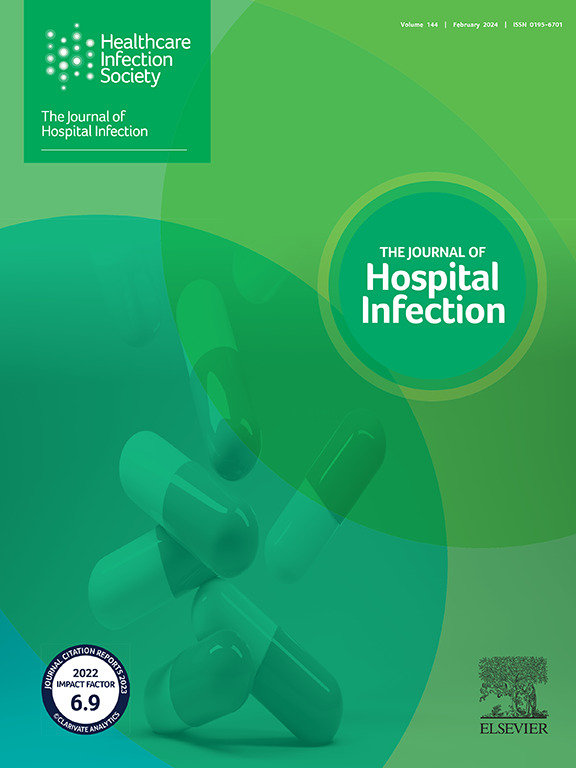耐药革兰氏阴性菌定植在治疗干细胞移植后发热性中性粒细胞减少症中的作用。
IF 3.1
3区 医学
Q1 INFECTIOUS DISEASES
引用次数: 0
摘要
导言:发热性中性粒细胞减少症是干细胞移植最常见的并发症之一:发热性中性粒细胞减少症(FN)是干细胞移植最常见的并发症之一。本分析的目的是评估FN患者定植耐药革兰氏阴性菌(广谱β-内酰胺酶阳性、耐多药(MDR)铜绿假单胞菌)后发生败血症的频率,以及定植患者主要抗生素的选择:这是一项回顾性研究,分析了2018年1月1日至2022年9月9日接受造血干细胞移植患者的数据。数据来自医院信息系统:10.9%的非定植+/-AmpC患者、31.5%的ESBL+患者和0%的MDR铜绿假单胞菌患者选择碳青霉烯作为主要抗生素。FN 和 MDR 铜绿假单胞菌定植患者的败血症发病率较高(即 100%,p = 0.0197)。败血症的谱系似乎有所不同,ESBL+组中革兰氏阴性杆菌占多数(p = 0.0123,OR 5.39 [95% CI 1.55-18.76])。MDR铜绿假单胞菌定植的脓毒症患者中100%出现定植者脓毒症(p=0.002),所有患者均为异体移植(p=0.0003),死亡率为33.3%(p=0.0384)。ESBL+定植患者的败血症发生率为25.9%(p=0.0197),其中50%的败血症病例为定植败血症(p=0.0002),大部分为异体移植(p=0.0003):结果表明,铜绿假单胞菌MDR定植的FN患者发生败血症的风险很高,这种情况几乎完全由定植者引起。同时,ESBL+细菌定植的患者发生革兰氏阴性败血症的风险更高。本文章由计算机程序翻译,如有差异,请以英文原文为准。
The role of colonization with resistant Gram-negative bacteria in the treatment of febrile neutropenia after stem cell transplantation
Background
Febrile neutropenia (FN) is a common complication of stem cell transplantation.
Aim
To evaluate the frequency of sepsis in patients with FN colonized with resistant Gram-negative bacteria (extended-spectrum β-lactamase (ESBL)-positive, multidrug-resistant (MDR) Pseudomonas aeruginosa) and the choice of primary antibiotic in colonized patients.
Methods
This retrospective study analysed data from patients undergoing haematopoietic stem cell transplantation from January 2018 to September 2022. Data were extracted from the hospital information system.
Findings
Carbapenem as the primary antibiotic of choice was chosen in 10.9% of non-colonized +/–AmpC patients, 31.5% of ESBL+ patients, and 0% of MDR P. aeruginosa patients. Patients with FN and MDR P. aeruginosa colonization had a high prevalence of sepsis (namely 100%, P = 0.0197). The spectrum of sepsis appeared to be different, with Gram-negative bacilli predominating in the ESBL+ group (OR: 5.39; 95% CI: 1.55–18.76; P = 0.0123). Colonizer sepsis was present in 100% of sepsis with MDR P. aeruginosa colonization (P = 0.002), all in allogeneic transplantation (P = 0.0003), with a mortality rate of 33.3% (P = 0.0384). The incidence of sepsis in patients with ESBL+ colonization was 25.9% (P = 0.0197), with colonizer sepsis in 50% of sepsis cases (P = 0.0002), most in allogeneic transplantation (P = 0.0003).
Conclusion
The results show a significant risk of sepsis in FN with MDR P. aeruginosa colonization, a condition almost exclusively caused by the colonizer. At the same time, a higher risk of Gram-negative sepsis has been demonstrated in patients colonized with ESBL+ bacteria.
求助全文
通过发布文献求助,成功后即可免费获取论文全文。
去求助
来源期刊

Journal of Hospital Infection
医学-传染病学
CiteScore
12.70
自引率
5.80%
发文量
271
审稿时长
19 days
期刊介绍:
The Journal of Hospital Infection is the editorially independent scientific publication of the Healthcare Infection Society. The aim of the Journal is to publish high quality research and information relating to infection prevention and control that is relevant to an international audience.
The Journal welcomes submissions that relate to all aspects of infection prevention and control in healthcare settings. This includes submissions that:
provide new insight into the epidemiology, surveillance, or prevention and control of healthcare-associated infections and antimicrobial resistance in healthcare settings;
provide new insight into cleaning, disinfection and decontamination;
provide new insight into the design of healthcare premises;
describe novel aspects of outbreaks of infection;
throw light on techniques for effective antimicrobial stewardship;
describe novel techniques (laboratory-based or point of care) for the detection of infection or antimicrobial resistance in the healthcare setting, particularly if these can be used to facilitate infection prevention and control;
improve understanding of the motivations of safe healthcare behaviour, or describe techniques for achieving behavioural and cultural change;
improve understanding of the use of IT systems in infection surveillance and prevention and control.
 求助内容:
求助内容: 应助结果提醒方式:
应助结果提醒方式:


